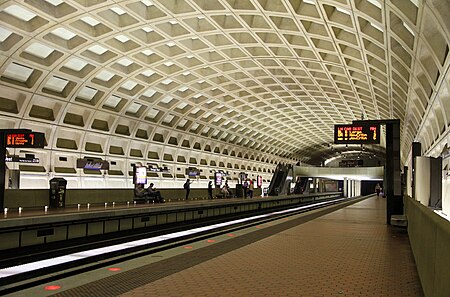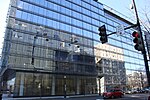Farragut West station

Farragut West is a side-platformed Washington Metro station in Downtown Washington, D.C., United States. The station was opened on July 1, 1977, and is operated by the Washington Metropolitan Area Transit Authority (WMATA). Providing service for the Blue, Silver, and Orange Lines, the station is located just west of Farragut Square with two entrances on I Street at 17th and 18th Streets, Northwest. While it is only a block away (across the square) from Farragut North station, there is no direct connection between the two stations. WMATA originally planned to have a single Farragut station that would serve as an alternate transfer station to ease congestion that would develop in Metro Center. However, it would have been constructed using the cut and cover method, disrupting the square above. Therefore, this proposal was not favored and the two separate stations were built instead. As part of its long-term capital improvement plan dated September 12, 2002, Metro has proposed building an underground pedestrian tunnel (similarly to the connection tunnel between Sofia (Bulgaria)’s Serdika and Serdika-2 metro stations) connecting this station with Farragut North. On October 28, 2011, Metro announced its Farragut Crossing program, allowing riders using a SmarTrip card up to 30 minutes to transfer for free by foot between Farragut West and Farragut North stations.The station opened on July 1, 1977. Its opening coincided with the completion of 11.8 miles (19.0 km) of rail between National Airport and RFK Stadium and the opening of the Arlington Cemetery, Capitol South, Crystal City, Eastern Market, Federal Center SW, Federal Triangle, Foggy Bottom–GWU, L'Enfant Plaza, McPherson Square, National Airport, Pentagon, Pentagon City, Potomac Avenue, Rosslyn, Smithsonian, and Stadium–Armory stations. This was the first station in the system to open without any pylons along the platform. Information normally found on the pylons is located on wall plaques. Orange Line service to the station began upon the line's opening on November 20, 1978. It is the sixth-busiest station in the Metrorail system, averaging 18,762 passengers per weekday in May 2017.Between January 15 to January 21, 2021, this station was closed because of security concerns due to the 2020 Inauguration.
Excerpt from the Wikipedia article Farragut West station (License: CC BY-SA 3.0, Authors, Images).Farragut West station
17th Street Northwest, Washington
Geographical coordinates (GPS) Address Nearby Places Show on map
Geographical coordinates (GPS)
| Latitude | Longitude |
|---|---|
| N 38.901361111111 ° | E -77.039472222222 ° |
Address
17th Street Northwest 900
20006 Washington
District of Columbia, United States
Open on Google Maps







